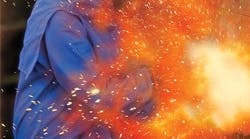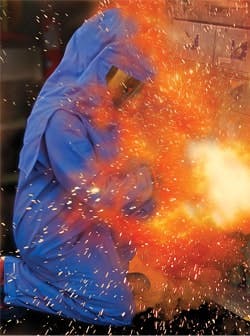In brief:
- In 1989, OSHA promulgated a much-needed regulation in the General Industry Regulations; 29 CFR 1910.147, the control of hazardous energy, or lockout/tagout.
- Almost parallel to 29 CFR 1910.147, the control of hazardous energy, OSHA established 29 CFR 1910.331-.335 (Electrical) Safety-Related Work Practices in Subpart S of the General Industry Regulations.
- Finally in 1995, OSHA was successful in promulgation of regulations for utility installations and utility-like installations of industrial facilities.
In 1989, OSHA promulgated a much-needed regulation in the General Industry Regulations; 29 CFR 1910.147, the control of hazardous energy, or lockout/tagout. Analysis at the time indicated that more than 14,000 injury incidents were occurring annually in industry as a result of “accidental activation.” This regulation was nicknamed the “machine lockout standard,” due to the fact that the regulations did not have specific provisions for the control of electrical energy for electrical work on utilization installations.
Furthermore, the regulation excluded electrical work on power generation, transmission, and distribution installations in utilities. This is typical of utility companies in the United States. There was an immediate response by industry to establish the Energy Control Program as required by the regulation. Equipment assessments, specific machine procedures, training for personnel, and lockout/tagout supplies were some of the action items necessary to meet the comprehensive compliance requirements put into effect by the regulation. The effects of implementing the requirements of this regulation have been felt throughout all industry in the United States. This implementation resulted in the reduction of tens of thousands of injury incidents and hundreds of fatalities since its inception in 1989.
[pullquote]
Almost parallel to 29 CFR 1910.147, the control of hazardous energy, OSHA established 29 CFR 1910.331-.335 (Electrical) Safety-Related Work Practices in Subpart S of the General Industry Regulations. Included in this new standard announced in 1990 were the requirements for electrical lockout/tagout for “qualified electrical workers” working on de-energized electrical utilization installations. The addition of the requirements specific for electrical work to the requirements in 1910.147 has equipped industry with the requirements to address the majority of the hazardous energy control issues encountered. Exceptions usually arose where the industry was involved in co-generation of electricity and also in owned power transmission lines, substations, or distribution facilities that were utility-like in design. These installations required procedures that were not totally addressed in 1910.147 or 1910.333, and industry was forced either to create or to borrow from utility organizations’ effective procedures.
Finally in 1995, OSHA was successful in promulgation of regulations for utility installations and utility-like installations of industrial facilities. 29 CFR 1910.269, electric power generation, transmission, and distribution, contained comprehensive regulations and addressed control of hazardous energy sources for power plant locations and also the much needed 1910.269(m), deenergizing lines and equipment for employee protection, which codified and clarified the use of “clearances” for hazardous electrical energy control in utility-like and utility installations.
| Mark Franks is an AVO Training Institute instructor, an authorized OSHA instructor, and a member of FOA, NFPA, IAEI, ASSE, and ASTM. Contact him at [email protected]. |
By late 1995, industry in the United States had comprehensive regulations for the control of hazardous energy sources covering utilization, utility-like, and utility installations. In addition to these performance-oriented regulations for hazardous energy control, OSHA decreed in 1910.335 the requirement for protecting workers from electrical arc flash and burning from electrical explosions. OSHA further expanded the requirements to protect workers from arc flash hazards in 1910.269 by prohibiting a worker from wearing clothing that could be ignited and continue to burn, thus increasing the extent of injury to the worker. Certain fabrics or blends of fabrics that would burn readily or melt when exposed to flames or electric arcs were prohibited. The NFPA 70E 1995 Edition, formally identified the arc flash hazard and promoted the analysis of the hazard in the workplace.
Following 1995, industry in the United States had studied, tested, invented, tried, failed, succeeded, and moved forward in addressing the complex issues of arc flash hazard analysis. Successive NFPA 70E standards and the IEEE 1584 IEEE Guide for Performing Arc-Flash Hazard Calculations of 2002 have catapulted the process of calculating and analyzing arc flash energy. Protective equipment innovations have generated numerous options for protection of workers in wearing apparel, as well as arc flash protective suits ranging from 15 cal/cm2 to 100 cal/cm2 of incident energy.
Fast forward to 2013, and most industries know about arc flash hazard analysis. Many companies have completed the comprehensive engineering-supervised studies required to produce the results and have undertaken the hazard labeling of equipment, training of personnel, and application of arc-rated protective wearing apparel and arc-rated flash protective suits necessary to protect employees. Much of industry today has completed the analysis or it’s currently in progress or the analysis is planned for the near future to meet the compliance requirement and to stave off the possibility of a severe arc flash incident. Arc flash hazard analysis has a significant impact on the energy control program and specific equipment procedures for lockout/tagout. Many locations are experiencing changes in operational procedures necessary to address the levels of energy identified in the arc flash hazard analysis.
Figure 1: Special equipment, such as remote racking devices, remote open/close, personal protective equipment (PPE), arc flash blankets, and rescue equipment, could spur a reevaluation of how energy control for de-energized work is performed.
Staff training, qualifications, safety backups, and maintenance of PPE are just a few of the issues being addressed (Figure 1).
Today, industry in the United States is experiencing:
- significant expense associated with the engineering studies necessary to identify arc flash hazards in the workplace
- the necessity of integrating the results of arc flash hazard analysis with current energy control procedures
- the need to train and re-train operational and maintenance personnel in arc flash hazards, PPE, and changes in energy control procedures
- significant expense in special equipment for remote operation, racking, and grounding, especially in locations identified with dangerous energy levels
- increased supervision and auditing responsibilities required to meet OSHA compliance requirements regarding electrical hazards and energy control.
In summary, competent engineering analysis, well-written energy control procedures integrating arc flash hazard analysis, training of personnel, PPE, and special equipment are requirements today and will continue to be addressed in future years.

